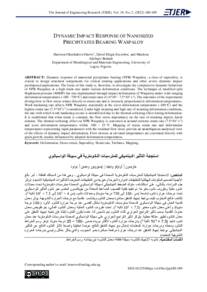Document
Dynamic impact response of nanosized precipitates bearing waspaloy.
Identifier
DOI:10.53540/tjer.vol19iss2pp180-189
Source
Journal of Engineering Research, v. 19, no. 2, p. 180-189.
Contributors
Esezobor, David Ehigie., Author
Bodude, Muideen Adebayo., Author
Other titles
الاستجابة الديناميكية لتأثير المترسبات النانومترية في سبيكة الواسبالوي.
Country
Oman.
City
Muscat
Publisher
College of Engineering, Sultan Qaboos University.
Gregorian
2022
Language
English
Subject
English abstract
Dynamic response of nanosized precipitates bearing (NPB) Waspaloy, a class of superalloy, is crucial to design structural components for critical rotating applications and other severe dynamic impact predisposed applications. The focus of this study is, therefore, to investigate the compressive dynamic behaviour of NPB Waspaloy at a high strain rate under various deformation conditions. The technique of modified split Hopkinson pressure (MSHP) bar was implemented through impact deformation of Waspaloy under wide-ranging deformation temperatures (-180 - 750 °C) and strain rates of (4×10³ - 7.5×10³ s⁻¹). The outcomes of the experiments divulge how flow stress relates directly to strain rate and is inversely proportional to deformation temperatures. Work hardening rate affects NPB Waspaloy maximally at the iciest deformation temperature (-180 °C) and the highest strain rate (7.5×10³ s⁻¹) considered. Under high straining and high rate of straining deformation conditions, the rate with which work-hardening occurs is destabilized due to the thermal softening effect during deformation. It is established that when strain is constant, the flow stress dependency on the rate of straining depicts a linear relation. The thermal softening effect on NPB Waspaloy is concerted at around extreme strain rate (7.5×10³ s⁻¹) and iciest deformation temperatures within -180 ~ 25 °C. Mapping of strain, strain rate and deformation temperatures representing input parameters with the resultant flow stress provides an unambiguous analytical view of the effects of dynamic impact deformation. Flow stresses at elevated temperatures are correlated directly with grain growth, mainly influenced by adopted deformation temperatures.
ISSN
Online: 1726-6742
Print: 1726-6009
Arabic abstract
الاستجابة الديناميكية للمترسبات النانومترية المحملة في سبيكة الواسبالوي، وهي فئة من السبائك الفائقة، تعد أمرًا بالغ الأهمية لتصميم المكونات الهيكلية للتطبيقات الدوارة الحرجة وغيرها من التطبيقات المعرضة للتأثيرات الديناميكية الشديدة. تركز هذه الدراسة، بالتالي، على استكشاف السلوك الديناميكي لضغط سبيكة الواسبالوي المحملة بمترسبات نانومترية تحت معدلات تشوه عالية وظروف تشوه متنوعة. تم تنفيذ تقنية القضيب الضاغط المعدلة من هوبكنسون المقسم عبر تشوه التأثير للواسبالوي تحت درجات حرارة تشوه شاسعة (من -180 إلى 750 درجة مئوية) ومعدلات تشوه من (4×10³ إلى 7.5×10³ ثانية⁻¹). تكشف نتائج التجارب كيف يرتبط إجهاد التدفق مباشرة بمعدل التشوه ويتناسب عكسيًا مع درجات الحرارة التشوهية. يؤثر معدل تقسية العمل في سبيكة الواسبالوي المحملة بمترسبات النانومترية بشكل أقصى عند درجة حرارة التشوه الأبرد (-180 درجة مئوية) وأعلى معدل تشوه (7.5×10³ ثانية⁻¹) معتبر. تحت ظروف التشوه العالية ومعدل التشوه العالي، يتم تقويض معدل حدوث التقسية بسبب تأثير التراجع الحراري أثناء التشوه. يتم تأسيس أنه عندما يكون التشوه ثابتًا، فإن تبعية إجهاد التدفق على معدل التشوه تظهر علاقة خطية. يتركز تأثير التراجع الحراري على سبيكة الواسبالوي المحملة بمترسبات النانومترية عند معدل تشوه شديد (7.5×10³ ثانية⁻¹) ودرجات حرارة التشوه الأكثر برودة ضمن -180 ~ 25 درجة مئوية. توفر رسم خرائط التشوه، معدل التشوه ودرجات حرارة التشوه كمعلمات إدخال مع إجهاد التدفق الناتج عرضًا تحليليًا واضحًا لآثار التشوه الناتج عن التأثير الديناميكي. يرتبط إجهاد التدفق عند درجات حرارة مرتفعة مباشرة بنمو الحبوب، والذي يتأثر بشكل رئيسي بدرجات الحرارة التشوهية المعتمدة.
Category
Journal articles

